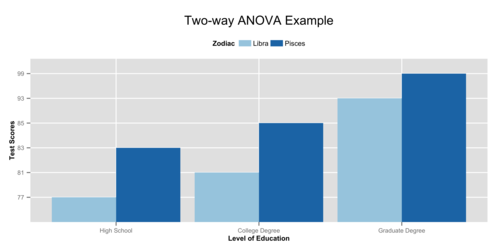ANOVA
"Analysis of Variance" (ANOVA) tests three or more groups for
mean differences
based on a continuous (i.e. scale or interval) response
variable (a.k.a. dependent variable).
There
are two main types of ANOVA:
(1) "one-way" ANOVA compares levels (i.e.
groups) of a single factor based on single continuous response variable
(e.g. comparing test score by 'level of education')
(2) a "two-way"
ANOVA compares levels of two or more factors for mean differences on a
single continuous response variable(e.g. comparing test score by both
'level of education' and 'zodiac sign'). (Like Paired T test)
In practice, you will see
one-way ANOVAs more often and when the term ANOVA is generically used,
it often refers to a one-way ANOVA.
One-way ANOVA has one continuous response variable (e.g. Test Score)
compared by three or more levels of a factor variable (e.g. Level of
Education).
Two-way ANOVA has one continuous response variable (e.g. Test Score)
compared by more than one factor variable (e.g. Level of Education and
Zodiac Sign)
ANCOVA
The obvious difference between ANOVA and ANCOVA is the the letter "C", which stands for 'covariance'. Like ANOVA, "Analysis of Covariance" (ANCOVA) has a single continuous response variable.
Unlike ANOVA, ANCOVA compares a
response variable by both a factor and a continuous independent variable
(e.g. comparing test score by both 'level of education' and 'number of
hours spent studying'). The term for the continuous independent variable used in ANCOVA is "covariate"
ANCOVA
compares a continuous response variable (e.g. Test Score) by levels of a
factor variable (e.g. Level of Education), controlling for a continuous
covariate (e.g. Number of Hours Spent Studying).
MANOVA
The obvious difference between ANOVA and a "Multivariate Analysis of Variance" (MANOVA) is the “M”, which stands for multivariate. In basic terms, A MANOVA is an ANOVA with two or more continuous response variables. Like ANOVA, MANOVA has both a one-way and a two-way . The number of factor variables involved distinguish a one-way MANOVA from a two-way MANOVA.
One-way MANOVA compares two or more continuous response variables (e.g.
Test Score and Annual Income) by a single factor variable (e.g. Level of
Education).





تعليقات
إرسال تعليق